Patient Safety Culture: Frameworks for Practice Change in Healthcare
VerifiedAdded on 2022/08/31
|7
|1629
|14
Essay
AI Summary
This essay delves into the critical importance of a patient safety culture within healthcare settings, drawing upon the case study of Hospital Hope to illustrate the consequences of its absence. The essay examines the factors that led to practice changes in the Surgical Intensive Care Unit (SICU), highlighting the significance of evidence-based practices, effective communication strategies, and the prevention of hospital-acquired infections. Furthermore, it explores the application of a sociotechnical framework as a means to implement and sustain a robust patient safety culture. This framework integrates technological advancements, organizational processes, and cultural considerations to enhance patient care and mitigate risks. The analysis underscores the interconnectedness of systems, people, and culture in fostering a safe and effective healthcare environment. The essay concludes by emphasizing the role of a patient safety culture in mitigating risks, improving patient outcomes, and fostering a culture of continuous learning and improvement within the healthcare system.
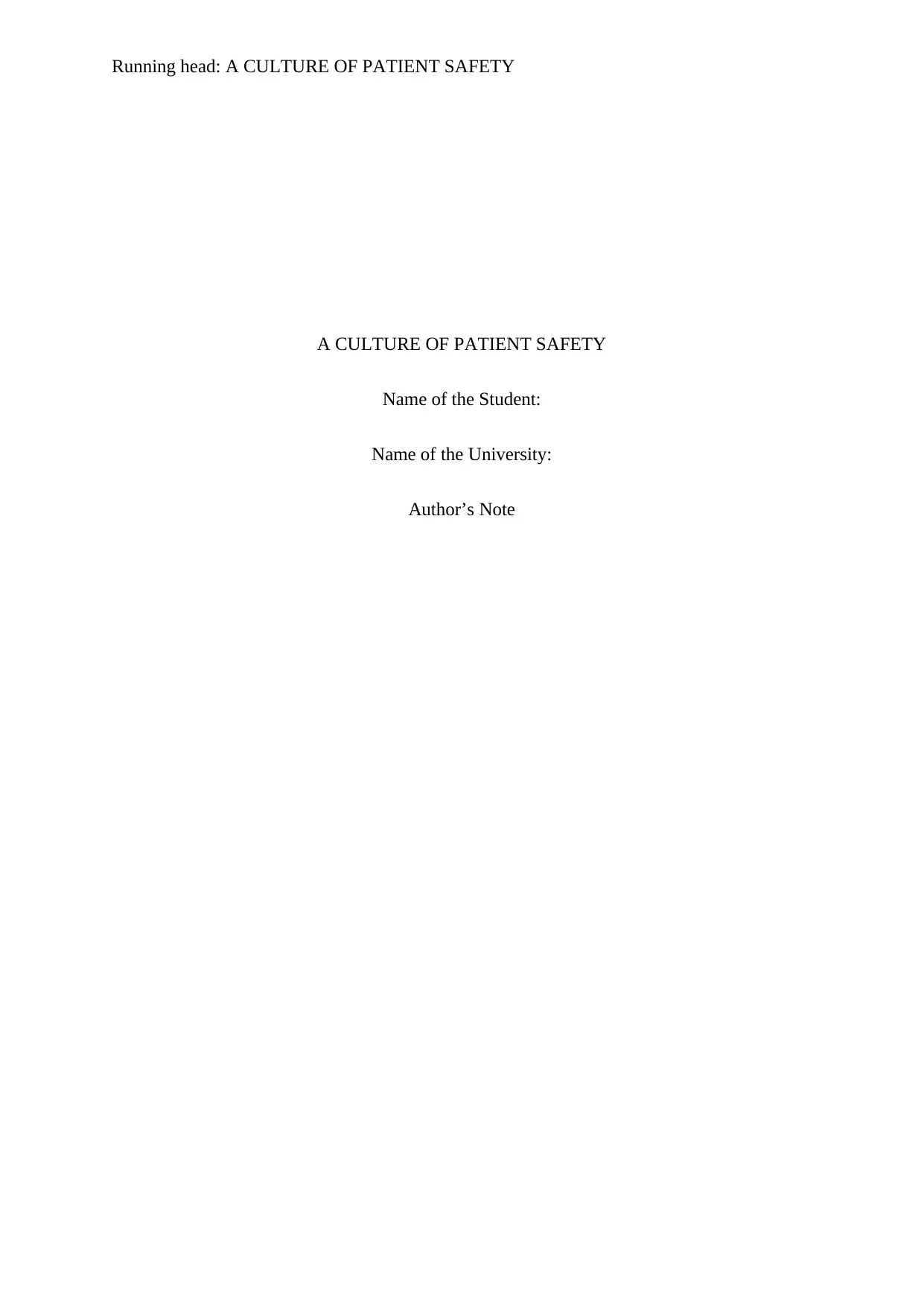
Running head: A CULTURE OF PATIENT SAFETY
A CULTURE OF PATIENT SAFETY
Name of the Student:
Name of the University:
Author’s Note
A CULTURE OF PATIENT SAFETY
Name of the Student:
Name of the University:
Author’s Note
Paraphrase This Document
Need a fresh take? Get an instant paraphrase of this document with our AI Paraphraser
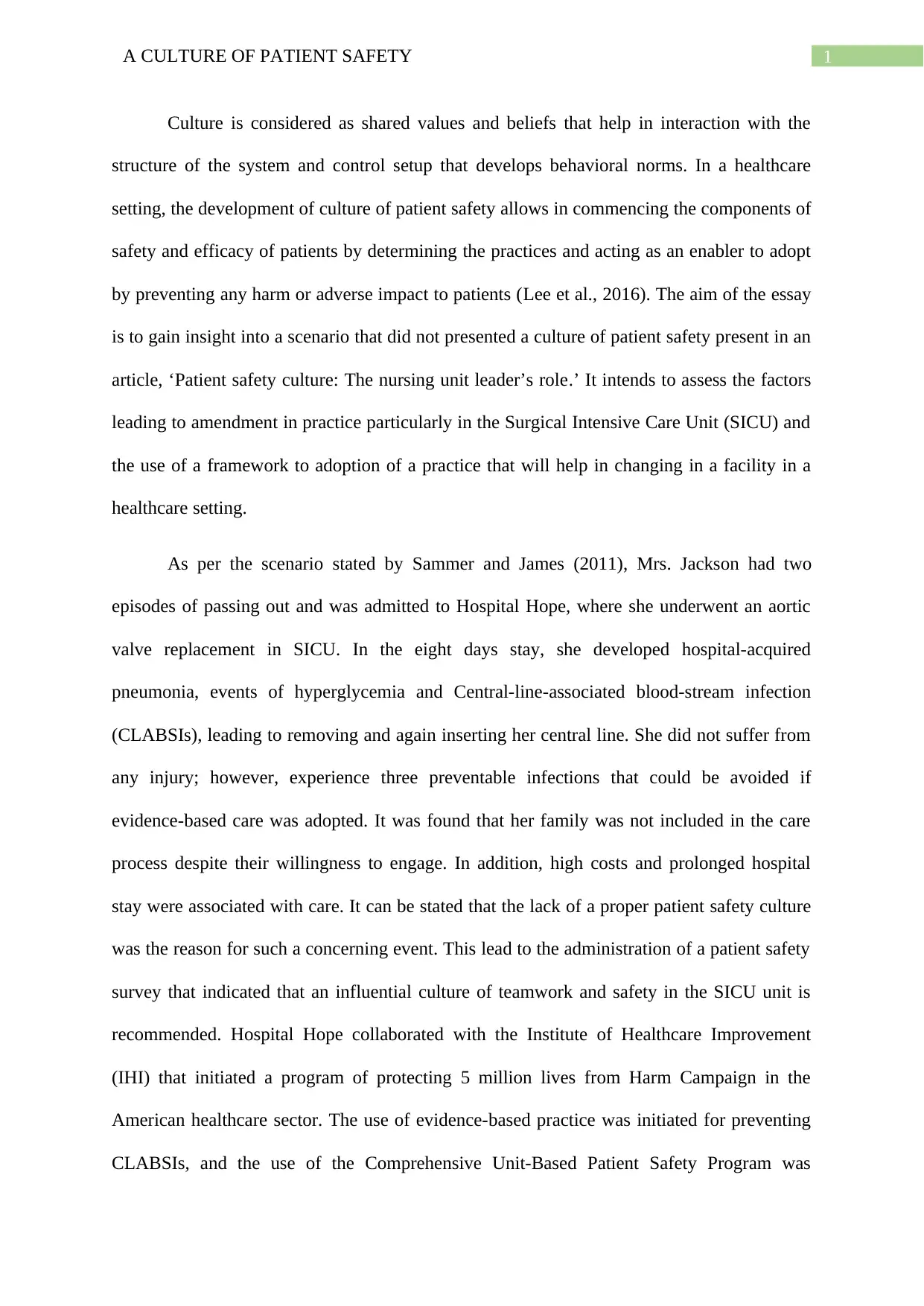
1A CULTURE OF PATIENT SAFETY
Culture is considered as shared values and beliefs that help in interaction with the
structure of the system and control setup that develops behavioral norms. In a healthcare
setting, the development of culture of patient safety allows in commencing the components of
safety and efficacy of patients by determining the practices and acting as an enabler to adopt
by preventing any harm or adverse impact to patients (Lee et al., 2016). The aim of the essay
is to gain insight into a scenario that did not presented a culture of patient safety present in an
article, ‘Patient safety culture: The nursing unit leader’s role.’ It intends to assess the factors
leading to amendment in practice particularly in the Surgical Intensive Care Unit (SICU) and
the use of a framework to adoption of a practice that will help in changing in a facility in a
healthcare setting.
As per the scenario stated by Sammer and James (2011), Mrs. Jackson had two
episodes of passing out and was admitted to Hospital Hope, where she underwent an aortic
valve replacement in SICU. In the eight days stay, she developed hospital-acquired
pneumonia, events of hyperglycemia and Central-line-associated blood-stream infection
(CLABSIs), leading to removing and again inserting her central line. She did not suffer from
any injury; however, experience three preventable infections that could be avoided if
evidence-based care was adopted. It was found that her family was not included in the care
process despite their willingness to engage. In addition, high costs and prolonged hospital
stay were associated with care. It can be stated that the lack of a proper patient safety culture
was the reason for such a concerning event. This lead to the administration of a patient safety
survey that indicated that an influential culture of teamwork and safety in the SICU unit is
recommended. Hospital Hope collaborated with the Institute of Healthcare Improvement
(IHI) that initiated a program of protecting 5 million lives from Harm Campaign in the
American healthcare sector. The use of evidence-based practice was initiated for preventing
CLABSIs, and the use of the Comprehensive Unit-Based Patient Safety Program was
Culture is considered as shared values and beliefs that help in interaction with the
structure of the system and control setup that develops behavioral norms. In a healthcare
setting, the development of culture of patient safety allows in commencing the components of
safety and efficacy of patients by determining the practices and acting as an enabler to adopt
by preventing any harm or adverse impact to patients (Lee et al., 2016). The aim of the essay
is to gain insight into a scenario that did not presented a culture of patient safety present in an
article, ‘Patient safety culture: The nursing unit leader’s role.’ It intends to assess the factors
leading to amendment in practice particularly in the Surgical Intensive Care Unit (SICU) and
the use of a framework to adoption of a practice that will help in changing in a facility in a
healthcare setting.
As per the scenario stated by Sammer and James (2011), Mrs. Jackson had two
episodes of passing out and was admitted to Hospital Hope, where she underwent an aortic
valve replacement in SICU. In the eight days stay, she developed hospital-acquired
pneumonia, events of hyperglycemia and Central-line-associated blood-stream infection
(CLABSIs), leading to removing and again inserting her central line. She did not suffer from
any injury; however, experience three preventable infections that could be avoided if
evidence-based care was adopted. It was found that her family was not included in the care
process despite their willingness to engage. In addition, high costs and prolonged hospital
stay were associated with care. It can be stated that the lack of a proper patient safety culture
was the reason for such a concerning event. This lead to the administration of a patient safety
survey that indicated that an influential culture of teamwork and safety in the SICU unit is
recommended. Hospital Hope collaborated with the Institute of Healthcare Improvement
(IHI) that initiated a program of protecting 5 million lives from Harm Campaign in the
American healthcare sector. The use of evidence-based practice was initiated for preventing
CLABSIs, and the use of the Comprehensive Unit-Based Patient Safety Program was
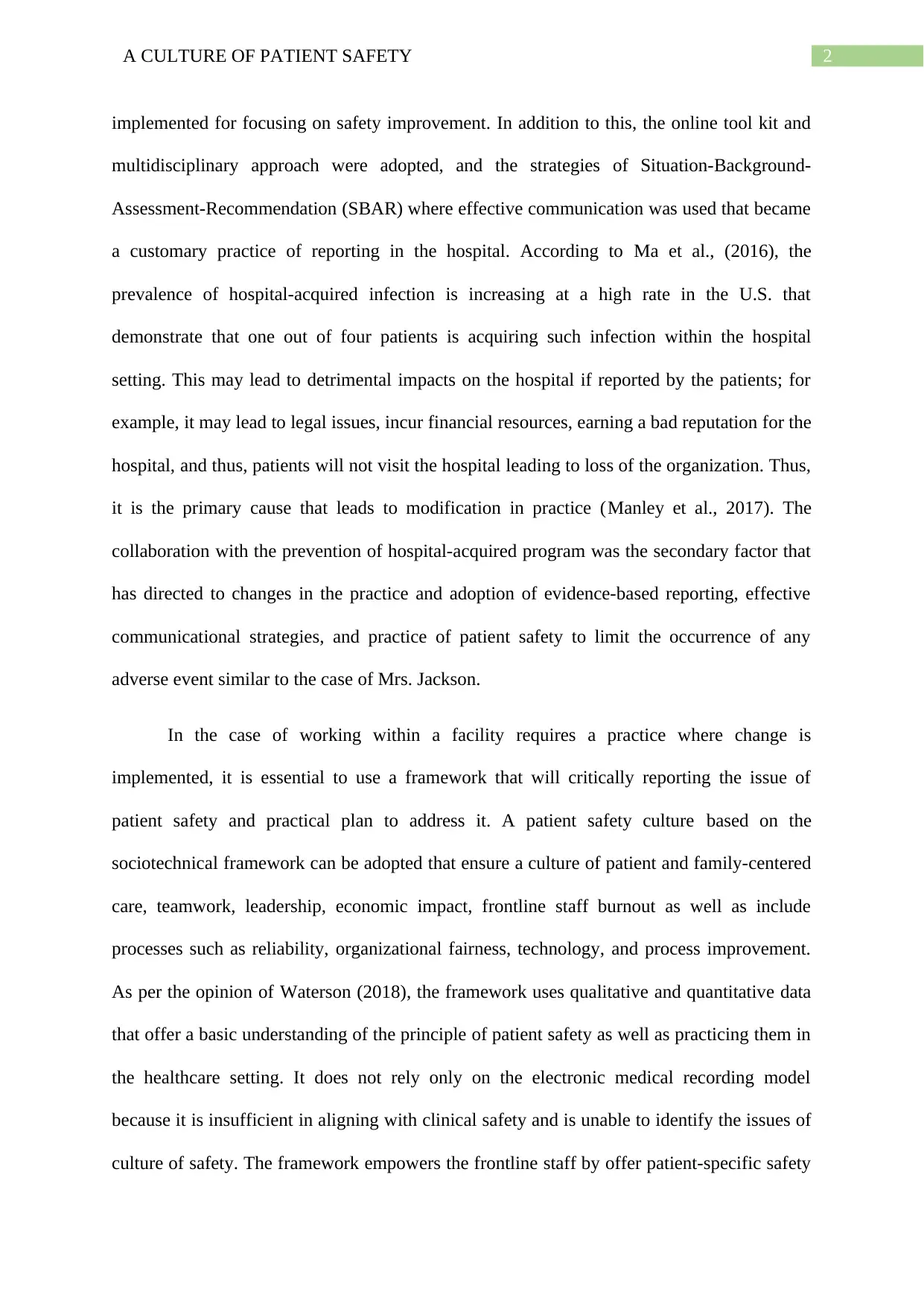
2A CULTURE OF PATIENT SAFETY
implemented for focusing on safety improvement. In addition to this, the online tool kit and
multidisciplinary approach were adopted, and the strategies of Situation-Background-
Assessment-Recommendation (SBAR) where effective communication was used that became
a customary practice of reporting in the hospital. According to Ma et al., (2016), the
prevalence of hospital-acquired infection is increasing at a high rate in the U.S. that
demonstrate that one out of four patients is acquiring such infection within the hospital
setting. This may lead to detrimental impacts on the hospital if reported by the patients; for
example, it may lead to legal issues, incur financial resources, earning a bad reputation for the
hospital, and thus, patients will not visit the hospital leading to loss of the organization. Thus,
it is the primary cause that leads to modification in practice (Manley et al., 2017). The
collaboration with the prevention of hospital-acquired program was the secondary factor that
has directed to changes in the practice and adoption of evidence-based reporting, effective
communicational strategies, and practice of patient safety to limit the occurrence of any
adverse event similar to the case of Mrs. Jackson.
In the case of working within a facility requires a practice where change is
implemented, it is essential to use a framework that will critically reporting the issue of
patient safety and practical plan to address it. A patient safety culture based on the
sociotechnical framework can be adopted that ensure a culture of patient and family-centered
care, teamwork, leadership, economic impact, frontline staff burnout as well as include
processes such as reliability, organizational fairness, technology, and process improvement.
As per the opinion of Waterson (2018), the framework uses qualitative and quantitative data
that offer a basic understanding of the principle of patient safety as well as practicing them in
the healthcare setting. It does not rely only on the electronic medical recording model
because it is insufficient in aligning with clinical safety and is unable to identify the issues of
culture of safety. The framework empowers the frontline staff by offer patient-specific safety
implemented for focusing on safety improvement. In addition to this, the online tool kit and
multidisciplinary approach were adopted, and the strategies of Situation-Background-
Assessment-Recommendation (SBAR) where effective communication was used that became
a customary practice of reporting in the hospital. According to Ma et al., (2016), the
prevalence of hospital-acquired infection is increasing at a high rate in the U.S. that
demonstrate that one out of four patients is acquiring such infection within the hospital
setting. This may lead to detrimental impacts on the hospital if reported by the patients; for
example, it may lead to legal issues, incur financial resources, earning a bad reputation for the
hospital, and thus, patients will not visit the hospital leading to loss of the organization. Thus,
it is the primary cause that leads to modification in practice (Manley et al., 2017). The
collaboration with the prevention of hospital-acquired program was the secondary factor that
has directed to changes in the practice and adoption of evidence-based reporting, effective
communicational strategies, and practice of patient safety to limit the occurrence of any
adverse event similar to the case of Mrs. Jackson.
In the case of working within a facility requires a practice where change is
implemented, it is essential to use a framework that will critically reporting the issue of
patient safety and practical plan to address it. A patient safety culture based on the
sociotechnical framework can be adopted that ensure a culture of patient and family-centered
care, teamwork, leadership, economic impact, frontline staff burnout as well as include
processes such as reliability, organizational fairness, technology, and process improvement.
As per the opinion of Waterson (2018), the framework uses qualitative and quantitative data
that offer a basic understanding of the principle of patient safety as well as practicing them in
the healthcare setting. It does not rely only on the electronic medical recording model
because it is insufficient in aligning with clinical safety and is unable to identify the issues of
culture of safety. The framework empowers the frontline staff by offer patient-specific safety
⊘ This is a preview!⊘
Do you want full access?
Subscribe today to unlock all pages.

Trusted by 1+ million students worldwide
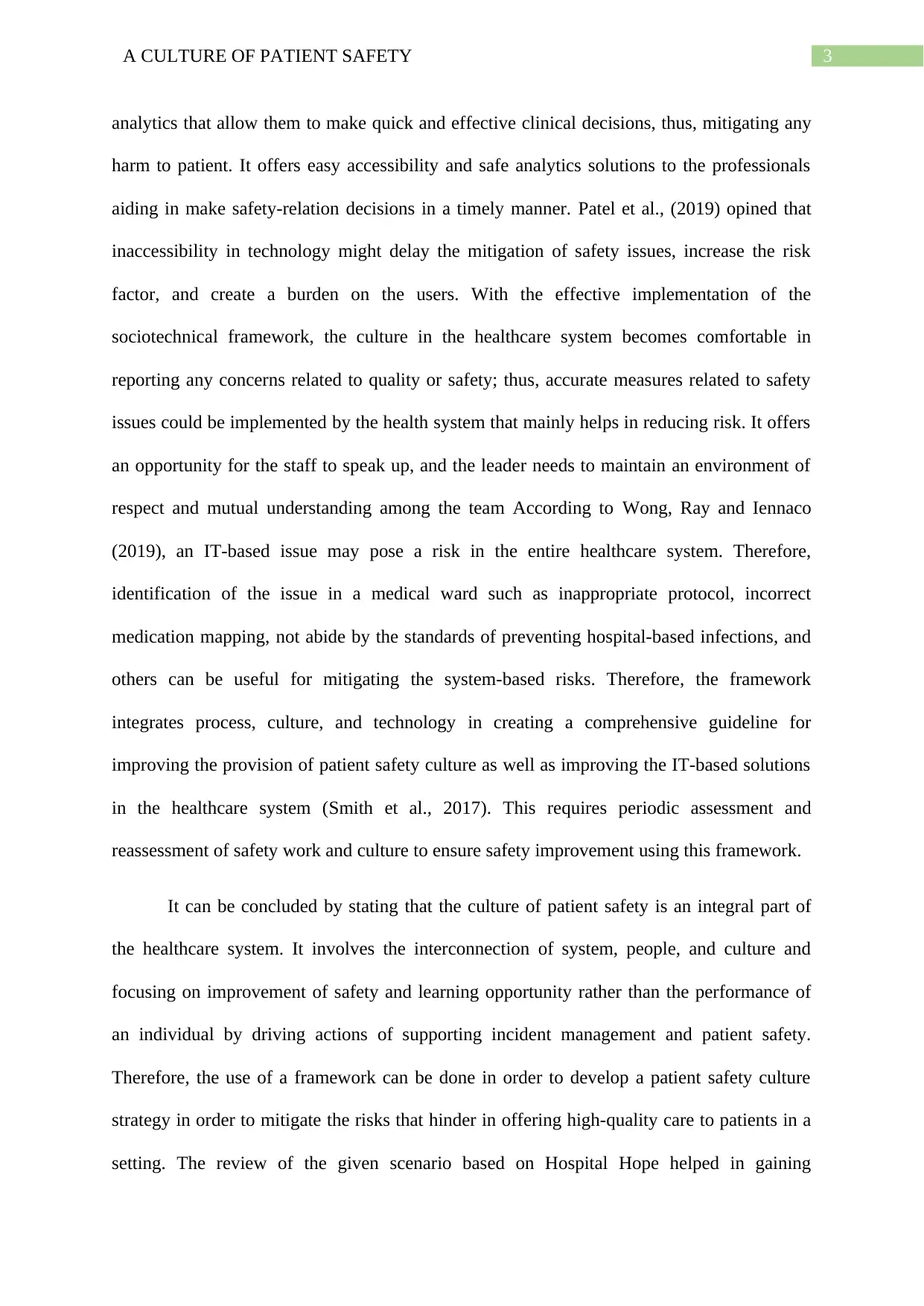
3A CULTURE OF PATIENT SAFETY
analytics that allow them to make quick and effective clinical decisions, thus, mitigating any
harm to patient. It offers easy accessibility and safe analytics solutions to the professionals
aiding in make safety-relation decisions in a timely manner. Patel et al., (2019) opined that
inaccessibility in technology might delay the mitigation of safety issues, increase the risk
factor, and create a burden on the users. With the effective implementation of the
sociotechnical framework, the culture in the healthcare system becomes comfortable in
reporting any concerns related to quality or safety; thus, accurate measures related to safety
issues could be implemented by the health system that mainly helps in reducing risk. It offers
an opportunity for the staff to speak up, and the leader needs to maintain an environment of
respect and mutual understanding among the team According to Wong, Ray and Iennaco
(2019), an IT-based issue may pose a risk in the entire healthcare system. Therefore,
identification of the issue in a medical ward such as inappropriate protocol, incorrect
medication mapping, not abide by the standards of preventing hospital-based infections, and
others can be useful for mitigating the system-based risks. Therefore, the framework
integrates process, culture, and technology in creating a comprehensive guideline for
improving the provision of patient safety culture as well as improving the IT-based solutions
in the healthcare system (Smith et al., 2017). This requires periodic assessment and
reassessment of safety work and culture to ensure safety improvement using this framework.
It can be concluded by stating that the culture of patient safety is an integral part of
the healthcare system. It involves the interconnection of system, people, and culture and
focusing on improvement of safety and learning opportunity rather than the performance of
an individual by driving actions of supporting incident management and patient safety.
Therefore, the use of a framework can be done in order to develop a patient safety culture
strategy in order to mitigate the risks that hinder in offering high-quality care to patients in a
setting. The review of the given scenario based on Hospital Hope helped in gaining
analytics that allow them to make quick and effective clinical decisions, thus, mitigating any
harm to patient. It offers easy accessibility and safe analytics solutions to the professionals
aiding in make safety-relation decisions in a timely manner. Patel et al., (2019) opined that
inaccessibility in technology might delay the mitigation of safety issues, increase the risk
factor, and create a burden on the users. With the effective implementation of the
sociotechnical framework, the culture in the healthcare system becomes comfortable in
reporting any concerns related to quality or safety; thus, accurate measures related to safety
issues could be implemented by the health system that mainly helps in reducing risk. It offers
an opportunity for the staff to speak up, and the leader needs to maintain an environment of
respect and mutual understanding among the team According to Wong, Ray and Iennaco
(2019), an IT-based issue may pose a risk in the entire healthcare system. Therefore,
identification of the issue in a medical ward such as inappropriate protocol, incorrect
medication mapping, not abide by the standards of preventing hospital-based infections, and
others can be useful for mitigating the system-based risks. Therefore, the framework
integrates process, culture, and technology in creating a comprehensive guideline for
improving the provision of patient safety culture as well as improving the IT-based solutions
in the healthcare system (Smith et al., 2017). This requires periodic assessment and
reassessment of safety work and culture to ensure safety improvement using this framework.
It can be concluded by stating that the culture of patient safety is an integral part of
the healthcare system. It involves the interconnection of system, people, and culture and
focusing on improvement of safety and learning opportunity rather than the performance of
an individual by driving actions of supporting incident management and patient safety.
Therefore, the use of a framework can be done in order to develop a patient safety culture
strategy in order to mitigate the risks that hinder in offering high-quality care to patients in a
setting. The review of the given scenario based on Hospital Hope helped in gaining
Paraphrase This Document
Need a fresh take? Get an instant paraphrase of this document with our AI Paraphraser
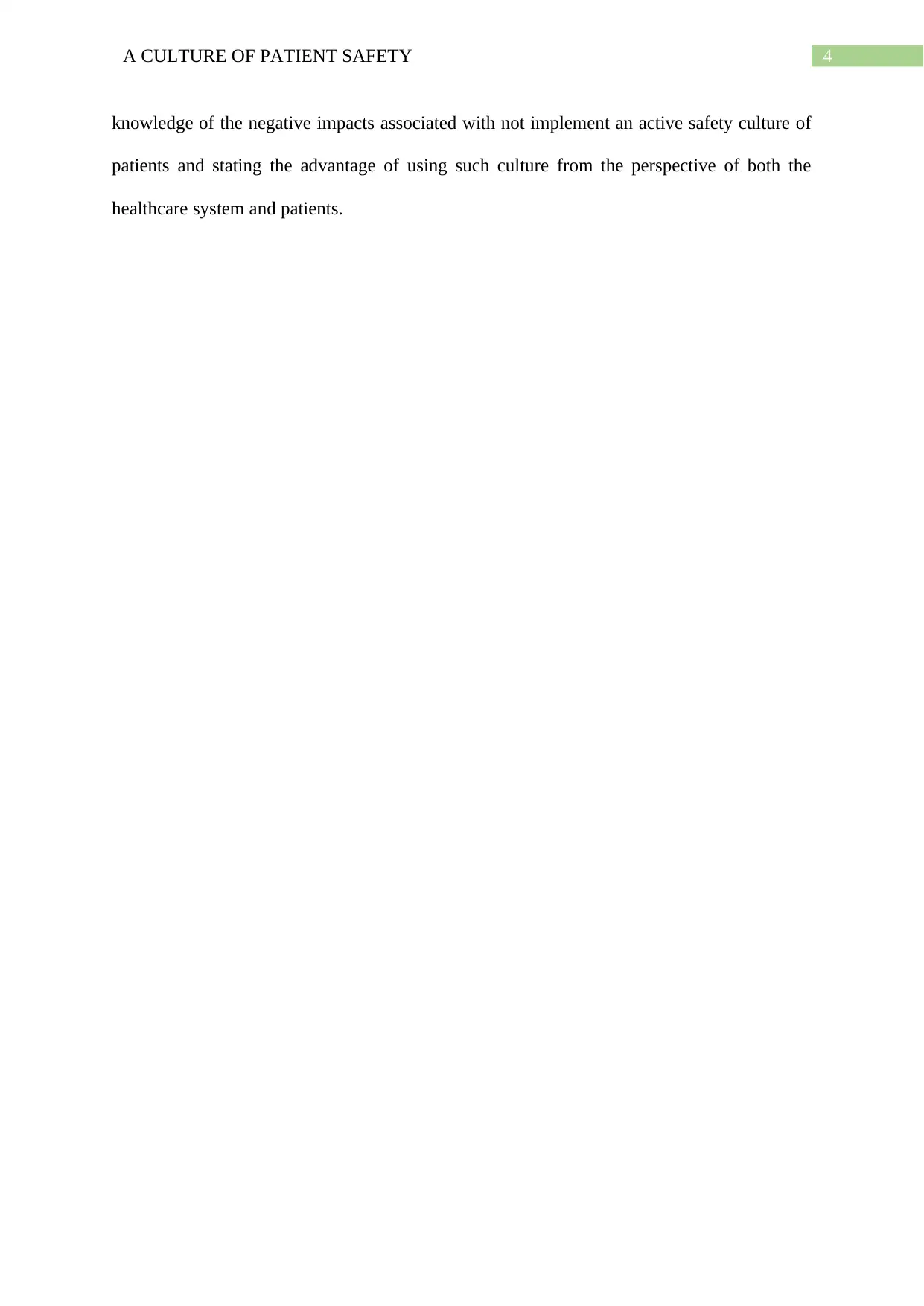
4A CULTURE OF PATIENT SAFETY
knowledge of the negative impacts associated with not implement an active safety culture of
patients and stating the advantage of using such culture from the perspective of both the
healthcare system and patients.
knowledge of the negative impacts associated with not implement an active safety culture of
patients and stating the advantage of using such culture from the perspective of both the
healthcare system and patients.
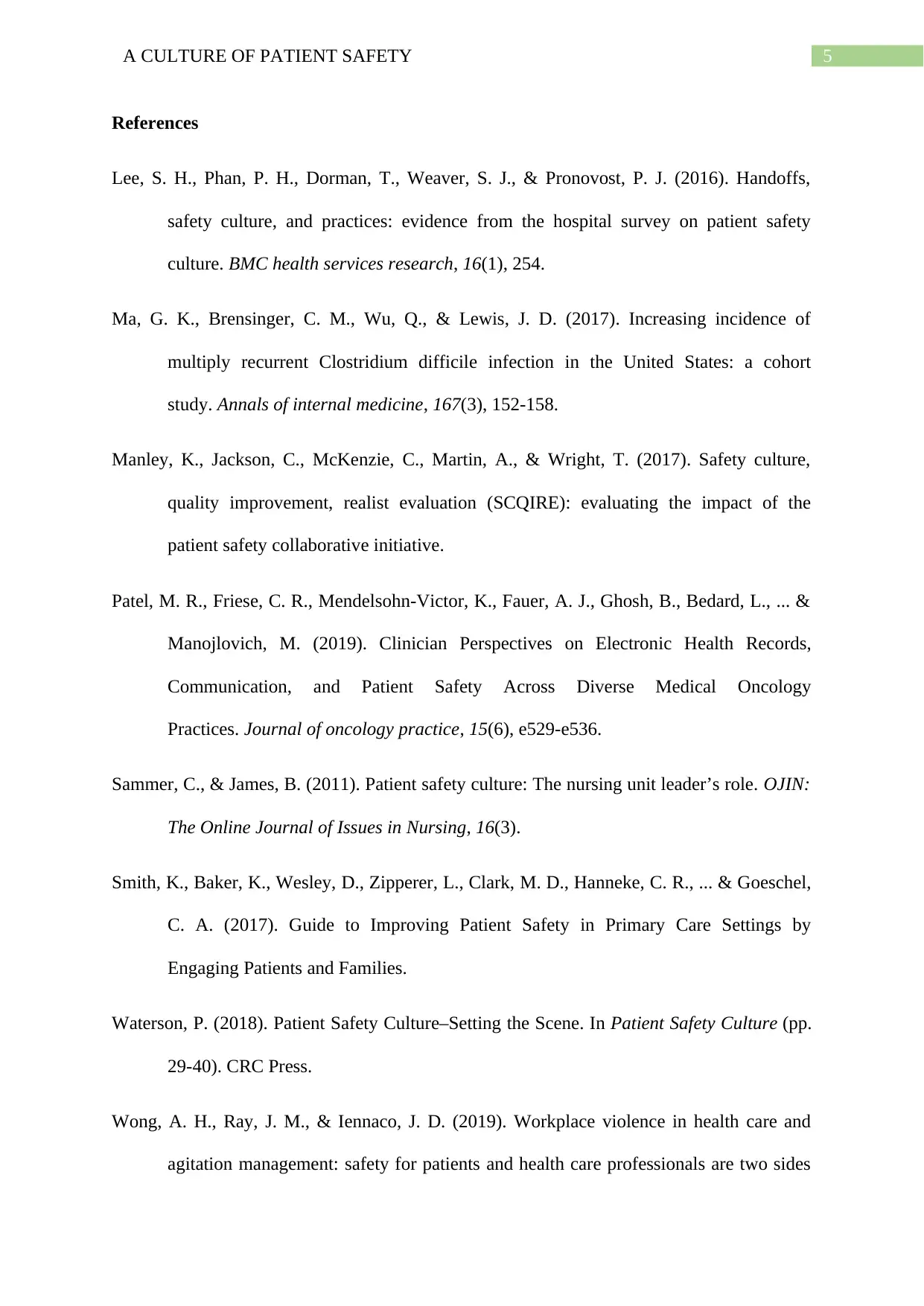
5A CULTURE OF PATIENT SAFETY
References
Lee, S. H., Phan, P. H., Dorman, T., Weaver, S. J., & Pronovost, P. J. (2016). Handoffs,
safety culture, and practices: evidence from the hospital survey on patient safety
culture. BMC health services research, 16(1), 254.
Ma, G. K., Brensinger, C. M., Wu, Q., & Lewis, J. D. (2017). Increasing incidence of
multiply recurrent Clostridium difficile infection in the United States: a cohort
study. Annals of internal medicine, 167(3), 152-158.
Manley, K., Jackson, C., McKenzie, C., Martin, A., & Wright, T. (2017). Safety culture,
quality improvement, realist evaluation (SCQIRE): evaluating the impact of the
patient safety collaborative initiative.
Patel, M. R., Friese, C. R., Mendelsohn-Victor, K., Fauer, A. J., Ghosh, B., Bedard, L., ... &
Manojlovich, M. (2019). Clinician Perspectives on Electronic Health Records,
Communication, and Patient Safety Across Diverse Medical Oncology
Practices. Journal of oncology practice, 15(6), e529-e536.
Sammer, C., & James, B. (2011). Patient safety culture: The nursing unit leader’s role. OJIN:
The Online Journal of Issues in Nursing, 16(3).
Smith, K., Baker, K., Wesley, D., Zipperer, L., Clark, M. D., Hanneke, C. R., ... & Goeschel,
C. A. (2017). Guide to Improving Patient Safety in Primary Care Settings by
Engaging Patients and Families.
Waterson, P. (2018). Patient Safety Culture–Setting the Scene. In Patient Safety Culture (pp.
29-40). CRC Press.
Wong, A. H., Ray, J. M., & Iennaco, J. D. (2019). Workplace violence in health care and
agitation management: safety for patients and health care professionals are two sides
References
Lee, S. H., Phan, P. H., Dorman, T., Weaver, S. J., & Pronovost, P. J. (2016). Handoffs,
safety culture, and practices: evidence from the hospital survey on patient safety
culture. BMC health services research, 16(1), 254.
Ma, G. K., Brensinger, C. M., Wu, Q., & Lewis, J. D. (2017). Increasing incidence of
multiply recurrent Clostridium difficile infection in the United States: a cohort
study. Annals of internal medicine, 167(3), 152-158.
Manley, K., Jackson, C., McKenzie, C., Martin, A., & Wright, T. (2017). Safety culture,
quality improvement, realist evaluation (SCQIRE): evaluating the impact of the
patient safety collaborative initiative.
Patel, M. R., Friese, C. R., Mendelsohn-Victor, K., Fauer, A. J., Ghosh, B., Bedard, L., ... &
Manojlovich, M. (2019). Clinician Perspectives on Electronic Health Records,
Communication, and Patient Safety Across Diverse Medical Oncology
Practices. Journal of oncology practice, 15(6), e529-e536.
Sammer, C., & James, B. (2011). Patient safety culture: The nursing unit leader’s role. OJIN:
The Online Journal of Issues in Nursing, 16(3).
Smith, K., Baker, K., Wesley, D., Zipperer, L., Clark, M. D., Hanneke, C. R., ... & Goeschel,
C. A. (2017). Guide to Improving Patient Safety in Primary Care Settings by
Engaging Patients and Families.
Waterson, P. (2018). Patient Safety Culture–Setting the Scene. In Patient Safety Culture (pp.
29-40). CRC Press.
Wong, A. H., Ray, J. M., & Iennaco, J. D. (2019). Workplace violence in health care and
agitation management: safety for patients and health care professionals are two sides
⊘ This is a preview!⊘
Do you want full access?
Subscribe today to unlock all pages.

Trusted by 1+ million students worldwide
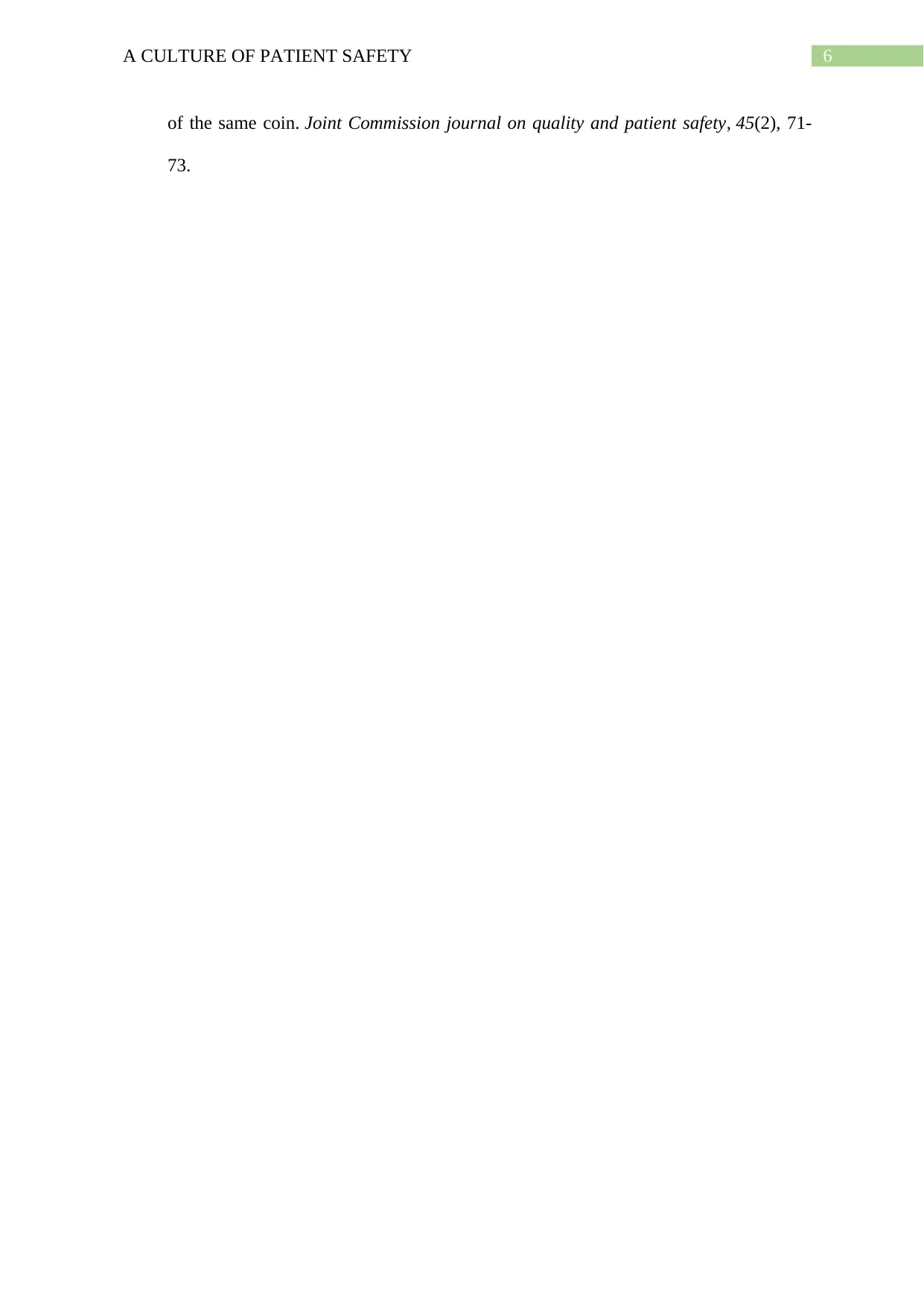
6A CULTURE OF PATIENT SAFETY
of the same coin. Joint Commission journal on quality and patient safety, 45(2), 71-
73.
of the same coin. Joint Commission journal on quality and patient safety, 45(2), 71-
73.
1 out of 7
Related Documents
Your All-in-One AI-Powered Toolkit for Academic Success.
+13062052269
info@desklib.com
Available 24*7 on WhatsApp / Email
![[object Object]](/_next/static/media/star-bottom.7253800d.svg)
Unlock your academic potential
Copyright © 2020–2025 A2Z Services. All Rights Reserved. Developed and managed by ZUCOL.





